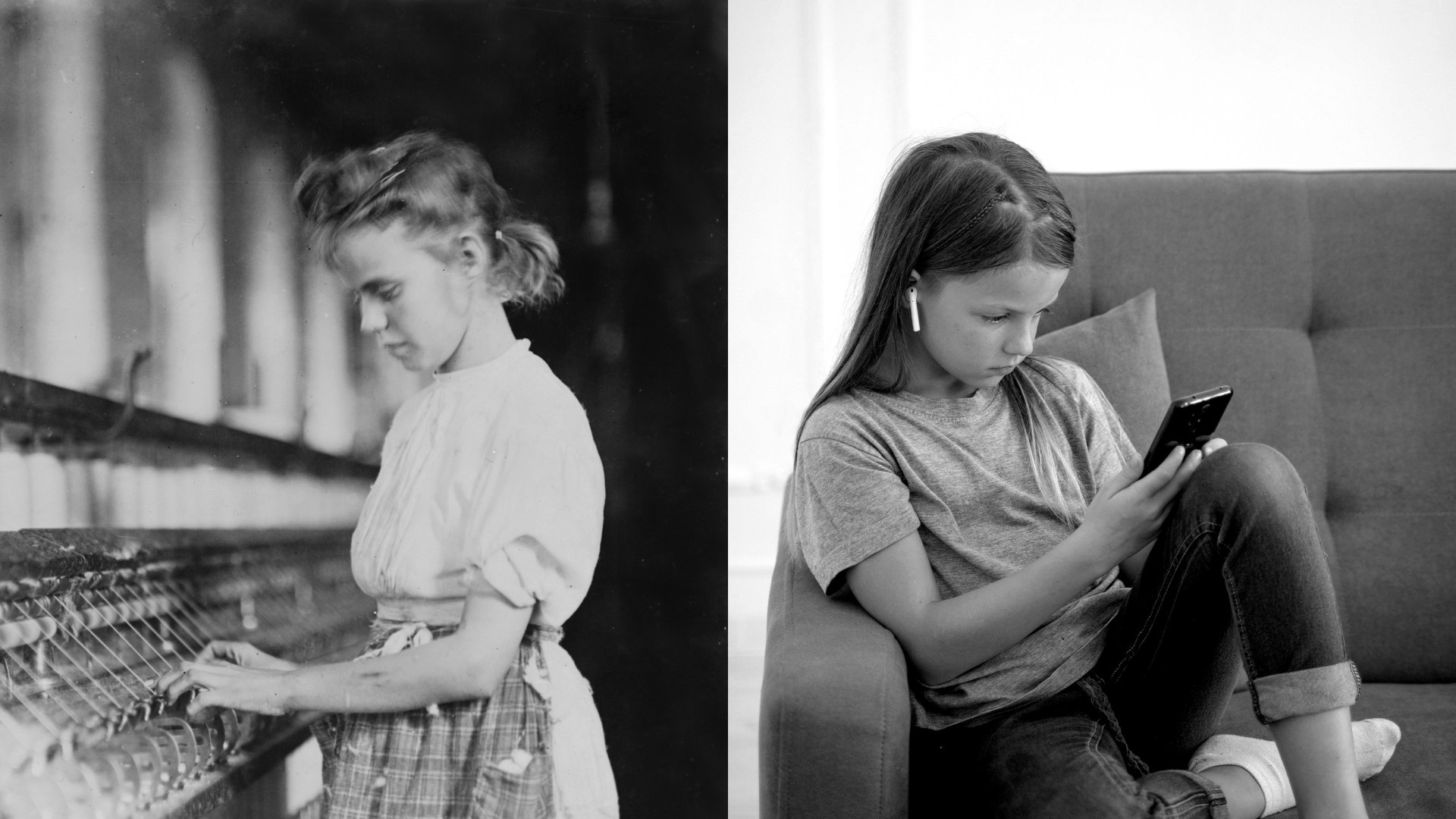Shawn Hamilton does what a lot of college-aged guys do on Christian campuses. He goes to class. He does his homework and reads his Bible. He plays video games, hangs out with his friends, and thinks about prevenient grace.
“The Holy Spirit tries to beckon people,” the 22-year-old told CT. “It’s more than just common grace, as Calvin articulates it. It’s the reason why all people can do good things. Because we are totally depraved, but it’s the Holy Spirit continuing in every life to give a little bit of light to respond to what God is doing.”
The focus on Wesleyan theology is perhaps a bit out of the ordinary.
But Hamilton attends Asbury Seminary in Kentucky, a school deeply grounded in the Wesleyan tradition. He was a Bible and theology major at Asbury University, so he’s interested in these kinds of things, and he also had a religious experience at a worship service at Asbury University as a freshman. His heart, as Methodist movement founder John Wesley famously described the experience, was “strangely warmed.”
“I felt an immense peace that I had never felt before in my entire life,” Hamilton said. “I cried in that moment because it was so warm and experiential, and that was a moment that really left me questioning, ‘What does it mean to be a Christian and live a Christian life?’”
After that, he found that the doctrines of grace and virtue developed by Methodist movement founder John Wesley in the 1700s started to make a lot of sense to him. As he tried to explain his experience of the Holy Spirit and his sense of what God wanted, Wesleyan theology felt like it fell into place.
Hamilton may not be unique here. There appears to be a growing number of young people drawn to Wesleyanism and Wesleyan-Arminian theology. Nearly 20 years after the rise of New Calvinism—when “Young, Restless, Reformed” Christians embraced the doctrinal system taught by French theologian John Calvin—there’s a new and renewed interest in another theological tradition, which has a bit of a different flavor.
Where Calvin taught predestination, Wesley believed that, through prevenient grace, God freed the human will sufficiently to accept or reject the offer of salvation. God predestined a plan of salvation, but not individual people.
Theologians in the Wesleyan tradition, like many Christians, emphasize the centrality, inspiration, and reliability of Scripture. They also teach the importance of sacraments. And many of them—though not all—are egalitarian, affirming that women can be gifted and called to ministry.
Wesley himself said he was just a “hair’s breadth” from Calvinism, and many Wesleyans, including Hamilton, think there’s just a different emphasis, not outright antagonism between the two positions.
However one thinks of the difference, it’s Wesleyanism today that has an energy and vibrancy drawing in people like Hamilton.
“Things have shifted,” said Brian Shelton, Asbury University’s Wesley Scholar in Residence. “Wesley is fire now.”
Groups of theologians are working to articulate Wesleyan theology in a fresh way. A small Wesleyan seminary has grown 500 percent in just six years. A new Wesleyan denomination, the Global Methodist Church, is sparking revived interest in the history and theology of the tradition and increased attention to spiritual practices, including Bible reading, worship, and prayer. Last year, a revival among the students at Asbury University drew international attention to Wesleyan spirituality.
Andy Miller III, a sixth-generation Salvation Army officer who has joined the Global Methodist Church and is currently a preaching and theology professor and president of Wesley Biblical Seminary (WBS), told CT this is an “amazing moment in Methodism.”
In addition to being president of a historically Wesleyan seminary, Miller leads More to the Story Ministries, which “exists to create content with orthodox Wesleyan convictions to serve the world in the name of Jesus Christ.” His weekly podcast boasts more than 750,000 views and downloads.
There is also a small fleet of Wesleyan institutions, including Seedbed, More to the Story, the Francis Asbury Society, the John Wesley Institute, the Fundamental Wesleyan Society, Firebrand Magazine, and Holy Joys.
Johnathan Arnold, who helped start Holy Joys in 2019, recalls he was steeped in Calvinist theology in high school. He read whatever was on his dad’s bookshelf and really loved a biography of Puritan theologian Jonathan Edwards and the Westminster Shorter Catechism. He also started reading contemporary Calvinist preachers and teachers, including John MacArthur, and watching videos of them on YouTube.
One day, however, he found a Q&A with a question that tripped him up on his path toward Calvinism. On the YouTube video, someone in the audience asked a Calvinist pastor how to explain to people who are not Christians that Jesus didn’t die for them.
“I thought, That’s a weird question,” Arnold told CT. “Surely he’s going to say, ‘Of course he died for the world. He’s not only a propitiation for our sins, but for the sins of the whole world’” (1 John 2:2).
Instead, the pastor said this was a complicated issue.
“That just blew me away,” Arnold, now 29, recalled.
It made him question whether Calvinism, which teaches a doctrine called “limited atonement,” was really biblical. He started looking around for other ways to systematize what Scripture said about God’s grace.
That’s when he discovered a book called Wesleyana, a collection of John Wesley’s writings. He liked what he read and found Wesleyanism to be a much more satisfying option. He started to identify as a Methodist.
Today, Arnold is senior pastor of Redeemer Wesleyan Church in Mount Pleasant Mills, Pennsylvania, and is president of Holy Joys. The organization seeks to equip local churches with Wesleyan-informed resources. It spends little time opposing Calvinism but instead tries to recover classical Methodist theology, much of it from the 19th century, developed by people such as Richard Watson, William Burt Pope, and Thomas Ralston.
“Of course, the name Holy Joys comes from John Wesley,” Arnold said. “In that little book, Wesleyana, that I read, one of the very first chapters is on true religion and in that chapter, Wesley says, ‘Christianity is holiness and happiness.’”
The Holy Joys Podcast has more than 25,000 downloads. A lot of listeners seem interested in questions about church structure, discipleship, and building a strong church community.
“Ecclesiology has really become the driving doctrine,” said Holy Joys board member David Fry, who is also senior pastor of Frankfort Bible Holiness Church in Frankfort, Indiana. “We want to write theology for the church and developing healthier churches.”
Chris Lohrstorfer, associate professor of Wesleyan theology at WBS, said Wesleyan ecclesiology offers a vision of the church as a community. Many people, in recent years, have craved a community-oriented Christian life, he said, and that has only increased in response to what some experts have called an “epidemic of loneliness.”
“The Wesleyan understanding of church and Christianity is … what our society is looking for,” Lohrstorfer said.
In addition to putting more Wesleyan sermons on its website, Holy Joys also has an event called the Holy Joys Healthy Church Conference. The first year, 50 people came. The second, that number almost doubled. Around 100 pastors and lay leaders came to the conference this year.
The next big project for Holy Joys is a new catechism, helping people teach its historic theological tradition in their local churches. The group has been working on this for several years.
The catechism won’t be the only new teaching document for a revived Wesleyanism. As CT reported in 2022, a group of 64 scholars from Wesleyan traditions came together to write a statement on the nature of God, Creation, revelation, salvation, the church, and eschatology or “the fullness of time.” The goal was to “shape the future of Methodism, define orthodox Wesleyanism, and ground more Christians in the story of sanctification and restoration through grace.”
Asbury University New Testament professor Suzanne Nicholson called it a “breath of fresh air” for Wesleyanism, presenting traditional teachings like sanctification in clear and compelling ways, that could connect with modern readers.
“This is a document that should lead people to joy at what Christ and the Spirit and the Triune God has done for us,” Nicholson said.
The interest in Wesleyanism has been bubbling for a few years, but an interest in the Arminian strain of Wesleyanism goes back even further. Matthew Pinson, president of Welch College, a Free Will Baptist school in Tennessee, points to the influence of scholarly work that started to come out in 2006 or 2007 in response to the new attention to Calvinism that CT chronicled in an article titled “Young, Restless, Reformed.”
“As young people started adopting Calvinism, and as they started bringing that into their classrooms in different colleges and seminaries,” he said, “professors and pastors who were against it began to see the need for more up-to-date theological material that would oppose it.”
Some dug into the works of Jacob Arminius, the Dutch theologian who critiqued Calvinism in the 16th century. Roger Olson, emeritus professor of Christian theology at Baylor University’s Truett Theological Seminary, wrote Arminian Theology, which was published by InterVarsity Press in 2006. Olson said Arminius’s teachings had for too long been seen as obscure theological wrangling, when actually they speak directly to one of the most pressing spiritual questions today.
“It’s relevant because people today want to know if God is good,” Olson, a self-described “Bapticostal,” told CT. “And Arminius explained how God can be sovereign and good.”
A few years later, theologian Leroy Forlines published Classical Arminianism. Pinson in 2022 released 40 Questions About Arminianism.
Their tradition is not Wesleyan but what Pinson and others refer to as Reformed Arminian or Classical Arminian theology. Classical Arminianism holds to the more Reformed positions Jacob Arminius held, such as radical depravity and the traditional notion of original sin. Classical Arminians also believe in imputation of the righteousness of Christ and apostasy coming only through defection from faith and being irremediable.
Pinson said Arminius offers people the beauty of Reformed theology without the problems of modern-day Calvinism. Arminianism also opens up a pathway from Reformed teachings to Wesleyanism, since Wesleyans teach Arminianism too.
For Wesleyans, the theological question is mostly about sin.
“While all Christian traditions believe God transforms us to the image of his Son, Wesleyan-Arminian thought confronts the sin that holds us back and expects a victory,” said Shelton, Asbury University’s Wesley scholar in residence. “The sanctification offered by Wesleyan-Arminian thought is a hope that is offered with strength.”
Christopher Bounds, who teaches theology at Asbury Seminary, said many of the students drawn to this historical theology seem especially attracted to the way Arminius, Wesley, and Wesleyans talk about grace.
“The Wesleyan-Arminian tradition recognizes that even repentance in faith that saves us is a gift of grace,” Bounds said.
Some of the institutions promoting revitalized Wesleyanism have been explicitly modeled on the New Calvinist movement. Organizations such as Desiring God, The Gospel Coalition, and IX Marks have been very influential and offer Wesleyans an example of how to promote their theological ideas.
“What do the Reformed got going?” said Fred Sanders, author of Wesley and the Christian Life and professor at Biola University. “They’ve got an infrastructure of generating a lot of online articles and a steady content stream.”
While Sanders teaches at the Torrey Honors College at Biola and is not a member of a historically Wesleyan church, he is contributing to a resurgence in interest in historic Wesleyan voices. He hosts a section on his personal website dedicated to the writings of 19th-century Methodist theologian William Burt Pope.
Some Wesleyans, watching the influence of Calvinists over the years, have felt compelled to offer an alternative.
“We have to be in the marketplace of ideas or we lose by default,” said Vic Reasoner, president emeritus of the Fundamental Wesleyan Society and director of the Francis Asbury Institute. “We have to be there to present our option. If people don’t know that there is this option in their pursuit of truth, they won’t even consider this option.”
Others just noticed a big void in popular presentations of Wesleyan thought and decided to fill it. That’s what happened to Jeffrey Rickman, who is pastor of Nowata Methodist Church, a Global Methodist congregation in Oklahoma and now hosts PlainSpoken, a YouTube channel that gets a few thousand views per video.
“There wasn’t really anybody doing it that I could see,” he said.
Starting a new organization to promote Wesleyan theology can provoke a good deal of trepidation, though. Matt Reynolds, president of Spirit & Truth, said he saw the need for a Wesleyan version of The Gospel Coalition for a long time. He kept meeting people who seemed to really need Wesleyan theology—spiritually hungry people, lacking in resources. But he doubted himself.
Reynolds finally asked a friend, United Theological Seminary professor David Watson, for his opinion.
“I think that God is calling me to do something here, but it sounds nuts to me,” Reynolds recalled telling Watson.
He explained his vision for a ministry that would go into local churches. They would train people, help them have a divine encounter to become empowered by the Holy Spirit, and mobilize them for mission. They would promote connections between Wesleyan churches and put on conferences and publish some stuff too.
“What do you think?” Reynolds asked when he finished. “Do you think I’m nuts?”
“No, I don’t think you’re nuts,” Watson said. “I think the Methodist world needs a ministry just like what you’re describing.”
Today, Watson serves as the lead editor for Spirit & Truth’s online publication, Firebrand Magazine. Watson champions the magazine as a place for “virtuous public conversations” in the midst of Methodist divisions. Firebrand launched in 2020, “around the time the United Methodist Church and Global Methodist Church rancor was reaching its high point,” he said.
Watson and others wanted to strike a semi-academic tone, publishing think pieces from the Wesleyan tradition that could help people who wanted to be more deeply rooted in the riches of Wesleyanism. The magazine could be a forum for debate among people who shared some key commitments and a theological vocabulary.
Today, the magazine gets about 40,000 hits a month, and the Firebrand podcast has about 1,500 downloads a month.
Firebrand and the other institutions promoting new interest in Wesleyanism don’t have the big names that New Calvinism did in the early 2000s. There are no figures equivalent to John Piper, Mark Driscoll, or Tim Keller. Partly this is intentional—a reaction to the perils of Christian celebrity. At the Asbury outpouring in 2023, one of the phrases repeated over and over was that there should be “no celebrity except Jesus.” Some Wesleyans argue that “radical humility” is an important part of the theological tradition.
“I would not expect, in any sort of Wesleyan-Arminian resurgence, that it would revolve around a certain personality or dogmatic preaching presence,” said Fry, the Holy Joys board member.
Historically, some of the most important early leaders of Methodism, including John Wesley, his brother Charles, and American bishop Francis Asbury, were not strong speakers, he said. They worked instead to build up the church and empower Christians to do the work of the gospel.
If a revitalized Wesleyan movement is successful, people in the movement say, it will not be because of one well-known preacher but many, many faithful ones.
Timothy Tennent, professor of World Christianity at Asbury Theological Seminary, said there’s reason to think that is going to happen. He pointed to the success of Seedbed Publishing House, which started 12 years ago and has published six of his books, including This We Believe! and The Call to Holiness, as well as a metrical psalter, a new hymnal, Bible study materials, and introductions to Wesleyan theology like The Absolute Basics of the Wesleyan Way.
Ryan Danker, director of the John Wesley Institute, said the book he co-edited with Asbury Seminary Professor Kenneth Collins, The Next Methodism, is one of Seedbed’s bestselling books. The popularity of the book shows the eagerness of regular churchgoers to learn more about Methodism.
The ministry also has a partnership with Zondervan, offers online courses, and launched an annual conference called New Room. Attendance has grown rapidly in the past few years, Tennent said.
Tennent is witnessing similar growth at Asbury Seminary. In his 15 years as president, he oversaw seven straight years of enrollment growth and the highest attendance numbers in the seminary’s 99-year history.
“I think there’s a lot of demonstrable evidence that Wesleyan theology now has a new surge and new voice that it didn’t have 10 or 15 years ago,” Tennent said.
Some of the leaders of this Methodist moment are cautious, though, about declaring it a revitalized movement, an Arminian comeback, or a rise of something that could be named “New Wesleyanism.”
Reynolds, at Spirit & Truth, says he sees a new spiritual hunger. Hamilton, the student at Asbury, just knows he’s found Wesleyanism to be really important to his spiritual life. Watson, at Firebrand, says maybe there’s not a full movement of new Methodism right now, but there could be soon.
“I think God is doing something,” Watson said. “I think God is raising up a new generation.”






















































